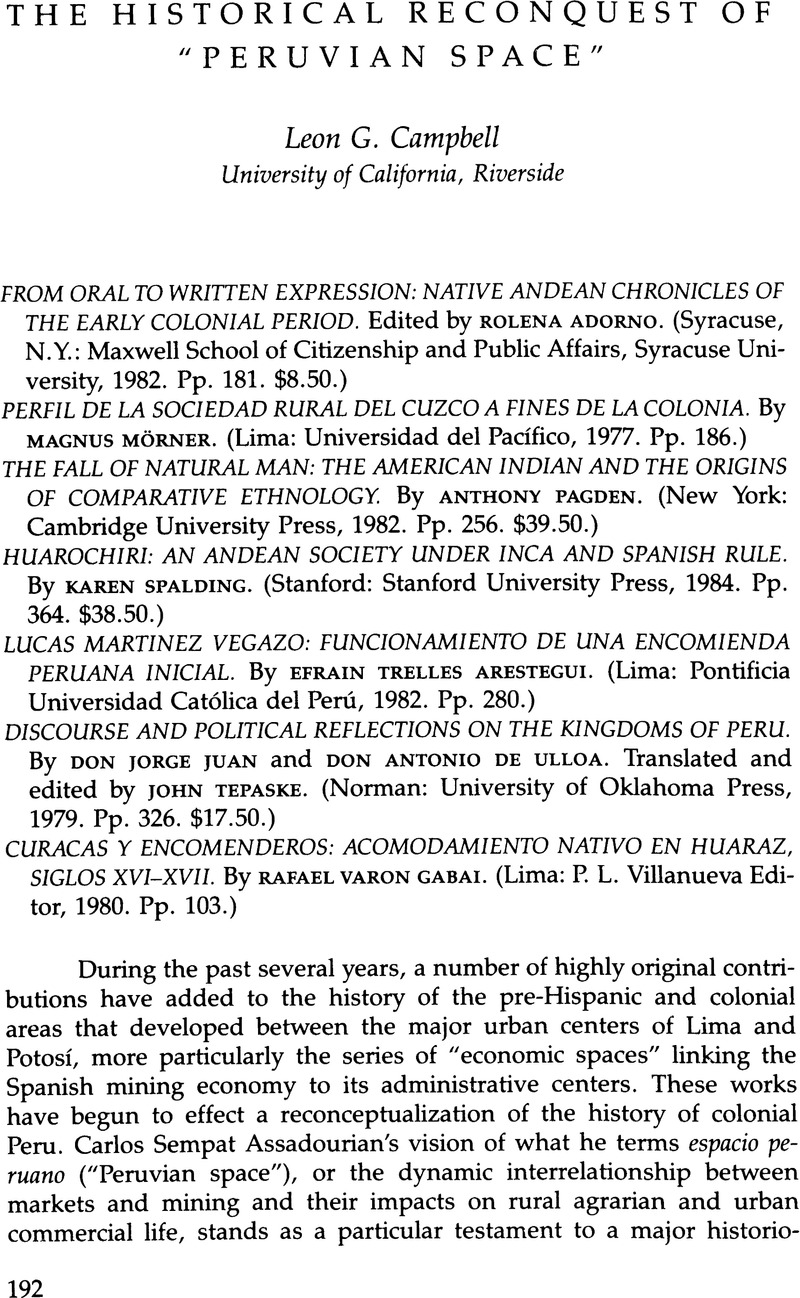No CrossRef data available.
Published online by Cambridge University Press: 12 October 2022

1. Carlos Sempat Assadourian, El sistema de la economía colonial: mercado interno, regiones y espacio económico (Lima, 1982). Sempat's work formed part of a working session entitled “New Directions in Andean History: An Analysis and Dialogue.” This session was organized by the Committee on Andean Studies of the Conference on Latin American History of the American Historical Association, which met in San Francisco on 28 December 1983. My comments in part reflect those of Professors Lawrence A. Clayton and Steve J. Stern, who narrated the session.
2. See Ensayos de Nueva Historia, edited by Wilfredo Kapsoli (Lima, 1983).
3. See, for example, Franklin Pease G. Y., “Historia andina: hacia una historia del Perú,” Revista Histórica (Lima) 32 (1979–80):197–212, which contains an extensive bibliography on the subject; also Heraclio Bonilla, “The New Profile of Peruvian History,” LARR 16, no. 3 (1981):210–24.
4. See Nathan Wachtel, The Vision of the Vanquished: The Spanish Conquest of Peru through Indian Eyes, 1530–1570, translated by Ben and Sian Reynolds (New York: Barnes and Noble, 1977).
5. Murra reviewed the field of ethnohistory in “Current Research and Prospects in Andean Ethnohistory,” LARR 5, no. 1 (1970):3–36. Since then a number of other reflections on the state of current research have appeared: for example, Luis Millones, “Ethnohistorians and Andean Ethnohistory: A Different Task, A Heterodox Discipline,” LARR 17, no. 1 (1982):200–216; and Frank Salomon, “Andean Ethnology in the 1970s: A Retrospective,” LARR 17, no. 2 (1982):75–128.
6. Carlos Contreras, “Nuevas tendencias en la historiografía peruana: las tesis de la Pontifica Universidad Católica del Perú, 1975–1982,” Histórica (Cuzco) 7, no. 1 (1983):111–22.
7. A specific example of this phenomenon at work might be the influence of the version of Garcilaso de la Vega's Comentarios reales edited in the eighteenth century by Andrés Gonzales de Barcia, which included Sir Walter Raleigh's alleged prophecy of Inca resurrection. This edition, which apparently influenced the Inca Tupac Amaru in 1780, was prohibited by Visitor General José Antonio de Areche in 1781, along with other memorials to Inca culture.
8. For example, see Nathan Wachtel's comments on the relationship of Andean cyclical time to the study of rebellion and millenial movements in eighteenth-century Peru in Sociedad e ideología: ensayos de historia y antropología andina (Lima, 1973), 50–51.